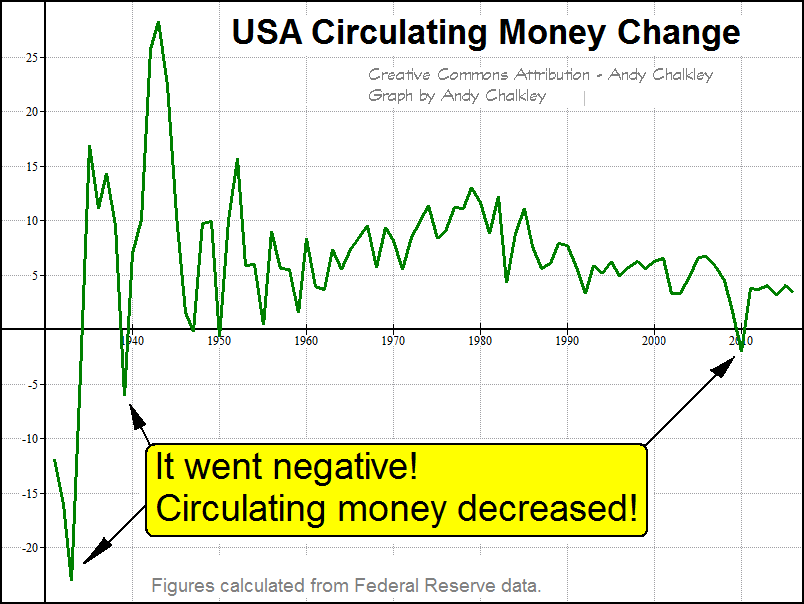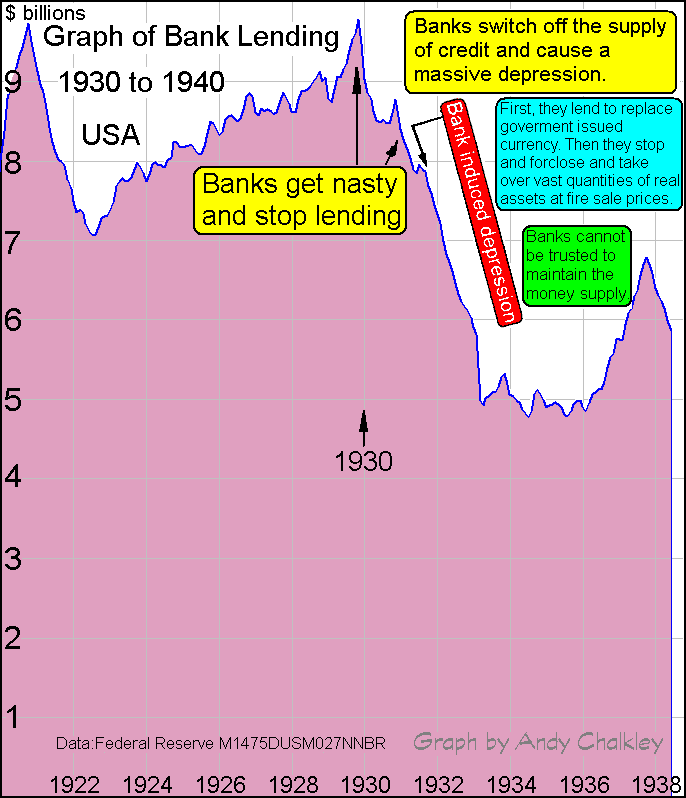
The concept of counter-cyclical finance is to provide credit when the private banks fail to do so. There appears to be a cyclical nature to the provision of Bank Credit to society by private banks. The private banks plentifully for a few years, then they slow the lending. The result of this is a fall in the magnitude of the Money Supply. The banks cut back on their lending whilst continuing to collect interest and repayments. This causes the Money Supply to contract. This is politely called an ‘economic shock’ which conveniently hides the origin of the Money Supply decrease. This can be seen in this graph. You can see a falter in the Money Supply and a fall in the volume of private debt:

This graph shows the percentage change in the Circulating Money against time:

This graph shows the change in lending during the inappropriately named ‘Great Depression’:

This graph shows the wildly changing level of Commercial and Industrial Loans:

The effect on business is magnified because the interest and repayments tend to come from Circulating Money rather than Hoarded Money. People with Hoarded Money tend not to borrow. Borrowing is done by those with no Hoarded Money. So when the Money Supply falls, the Circulating Money is liable to fall by a bigger percentage than the fall in the Money Supply.

I shall use the figures for Australia as an example (because they are the only ones I manage to remember). Up to 2015, the Reserve Bank of Australia has created $67 billion in cash folding notes. The Money Supply is listed as $1760 billion. This comprises the Cash Currency ($67 billion) and money in various bank accounts. Thus the bulk of the money in the nation is the credit listed in bank accounts. As the banks make loans, this figure increases. It is the main reason the Money Supply increases. Only 3.5% of the Money Supply increase comes from the Reserve Bank of Australia. The annual increase in the Money Supply significantly exceeds the volume of Cash Currency issued by the Central Bank. When loans are paid back, bank balances decrease. It is bank credit that is used to extinguish debt. If the rate of payment of ‘interest and repayments’ exceeds the rate of issue of new loans, the Money Supply falls. Thus the magnitude of the Money Supply entirely depends on the lending practices of the private banks. The notion that the government controls the Money Supply is incorrect. The government collects taxes, which citizens pay into a government bank account and the government spends the same money back out into society. The government collects pre-existing bank credit and spends the same bank credit back into society. This is why tax is called ‘government revenue’. The government does not use Cash Currency issued by the Reserve Bank of Australia. It pays its bills with Bank Credit.
The concept of counter-cyclical finance is to provide credit to the economy when the private banks fail to do so. This is effectively an admission that the private banking sector should not be trusted with the maintenance of the magnitude of the Money Supply. When private banks create the bulk of the Money Supply, the magnitude of the Money Supply is prone to rise and fall depending on the profit available to the private banks. Counter-cyclical finance is a ham-fisted attempt to enable the private banks to maintain their profitability without destroying the economy in the process. However, this counter-cyclical finance solution has benefits that go beyond repairing the problems created by private banking sector lending practices. The solution is for the government to bolster the Money Supply in the event of a reduction of the lending by private banking interests. This could be the treasury creating money in one of the forms of money, whether it be Cash Currency or bank credit. It could be as simple as the government setting up a bank owned by the government, commonly called a ‘public bank’. One form of a public bank is known as a ‘public development bank’ or national development bank. The role of a National Development Bank is to lend money into all levels of society for the purposes of infrastructure projects and national development and for business development at all levels right down to microfinance. The concept of counter-cyclical finance is that this same National Development Bank can lend whilst the private banks are having a ‘slack attack’. This makes good economic sense, but it also demonstrates the inadequacy of a money system dominated by private banks. It is an admission that a private-bank-dominated money system cannot be entrusted with the maintenance of a Money Supply. A government entity is required to do the heavy lifting when the private banks fail to maintain an adequate supply of money and credit in society. It is also of note that a National Development Bank is required to cover for the private banking system’s unwillingness or failure to provide credit for certain infrastructure projects. I am generally a pro-business type of person having run a few businesses in my time. I recognize that: when a government runs an operation, it becomes inefficient.

In the limit, a government enterprise avoids doing the task for which it was created and its daily efforts are absorbed in supporting its own infrastructure without providing service. You can imagine a department such as an ‘Inspectorate of Swimming Pools’ that has hundreds of staff in a multistory building walking around with sheets of paper calling meetings to decide on meeting schedules without ever sending inspectors out of the building. They may even collect swimming pool fees to cover their administration costs. However, when an operation is privatized, it tends to be profit-motivated, leading to cuts in service and increases in fees. An even bigger problem arises when private industry manages to engineer a monopoly situation or a group monopoly or cartel arrangement. Various inappropriate practices tend to occur. Money, water, military supplies, supermarkets and transport immediately come to mind.
This is not an argument against the use of a National Development Bank. It is a very strong reason for having a National Development Bank. The same logic also shows that private banks should not be trusted to maintain a Money Supply.
It is very necessary that the banking system, irrespective of whether it is private or public, should serve society and not just its own interests. Money needs to be channeled into appropriate investments and no level of business should be starved of funds to operate.
The private financial sector performed well in these areas. To make the situation worse, they have been over-lending in boom times and limiting credit in lean times in a pro-cyclical manner. Their lending has been inappropriate, has limited working capital and neglected long-term finance crucial for large projects. It has hampered the growth of businesses and employment. Small and medium enterprises have been particularly hurt by inadequate and costly credit.
National Development Banks correct the limitations of the private financial sector by providing counter-cyclical finance in lean times, effective finance to all levels and sizes of business for a dynamic economy and finance for public infrastructure.
In Brazil, their National Development Bank, the BNDES, served the nation well particularly during and after the 2008 crisis.When private bank lending fell after of the financial crisis, the BNDES continued lending. This countercyclical lending helped Brazil through the crisis much better than many other nations. [Bevins, 2010] [1]
Égert, 2010: “The banking system has become more pro-cyclical.” [3]
There are many reasons for the pro-cyclical behaviour in credit supply. This can arise for a number of reasons which are not destructive in intent. Banks tend to lend for profit. As such, they will naturally lend into the most profitable area. If that currently happens to be housing or financial assets it will push up the value of those assets until the profitability disappears in what some might call a bubble. The lending then falls. Business lending in the mean time has suffered from a lack of available credit and an increase in costs due to escalating costs due to inflated land prices affecting land rents for the business and its employees. The lack of available credit to business is particularly harmful to business. Business needs money before it can make money. Current bank lending practices tend to inflate asset prices and consequently, business costs, whilst hampering the development of the real economy by a reluctance to lend to business. The solution here is to create National Development Banks that have lending practices that:
National banks tend to be taken over by private interests. Banks have a massive lobby contingent at parliament with exceedingly long pockets. They argue strongly against the government running banks claiming unfair competition. They appear not to realise that the economy will be damaged by the pro-cyclical lending practices of their private banking industry. The private banking industry is ill-equipped to provide a stable Money Supply. Their lending is profit-driven with little concern for the health of the economy. When lending dries up, they simply repossess the houses that they accepted as collateral when they made the loans. with the consequent cyclical fluctuation in the Money Supply. The Central Bank is supposed to control the magnitude of the Money Supply but it is ill-equipped and incapable of doing so. It gives a good illusion in its attempts to do so all amplified by the press. National banks tend to be transferred to the private banking system.
In the 2008 reduction in lending, the solution used was slightly different. The government was induced to borrow more money in a process euphemistically called ‘Quantitative Easing’. The process involved the central bank acquiring government bonds. This enabled the Money Supply to be maintained, but the money fell into the hands of the hoarders and consequently the volume of Circulating Money did not increase. It is a process that is not well understood. The central bank, like the treasury, has the ability to create money out of thin air. Private banks create money in the form of Bank Credit when they make equal and opposite quantities of debt in the process called 'double entry bookkeeping'. During the 2008 crisis, the phrase Quantitative Easing covered for some clever actions.
Please read this article: “The positive role of good development banks” by Professor Stephany Griffith-Jones for the Third Annual Conference – ‘Financing For Development’ 20 May 2015 [2]